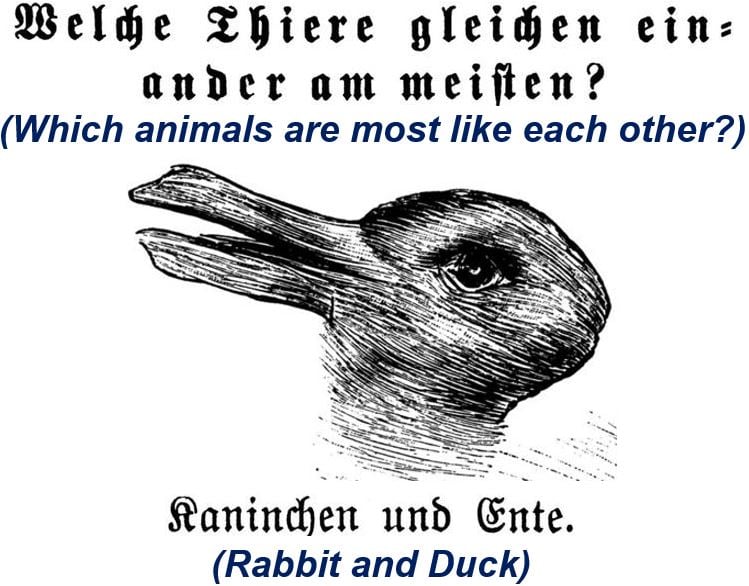If I can see a rabbit and then a duck and then a rabbit again rapidly, I am creative, according to American psychologist Joseph Jastrow in 1899 who presented a group of people with a drawing that could be a duck or a rabbit.
The famous Rabbit-Duck Illusion has been around for over a hundred years and is used by various experts, and also in party or family games.
According to Jastrow (1863-1944), a Polish-born American citizen who became famous for inventions in experimental psychology, optical illusions, psychophysics and design of experiments, how fast somebody can see either a duck or rabbit and how rapidly they can switch from one to the other, determines how quickly their brain works and how creative they are.
 The Rabbit-Duck Illusion is believed to have started in the 23rd October 1892 issue of Fliegende Blätter, a German humour magazine. It became a popular theme very rapidly, and appears to have made a comeback in social media websites. (Image: Wikipedia)
The Rabbit-Duck Illusion is believed to have started in the 23rd October 1892 issue of Fliegende Blätter, a German humour magazine. It became a popular theme very rapidly, and appears to have made a comeback in social media websites. (Image: Wikipedia)
Rabbit-Duck Illusion has gone viral
The Rabbit-Duck Illusion has been recently shared in online social media and sparked a huge reaction. Everybody seems to be commenting on what they see, and then passing on the sketch.
Jastrow was not the first person to draw the Rabbit-Duck Illusion. An unattributed drawing of it appeared on 23rd October, 1892, in the German humour magazine Fliegende Blätter (‘Flying Leaves’). Above the drawing was the caption ‘Welche Thiere gleichen einander am meisten?’ (‘Which animals are most like each other?’), with ‘Kaninchen und Ente’ (‘Rabbit and Duck’) written below.
Experts say that an individual’s result – how quickly an animal is spotted and how rapidly he or she can switch – typically changes at different times during the year.
 Today, there are several variations of the Rabbit-Duck Illusion. This one was tweeted by ALIF. Can you switch from rabbit to duck and back? (Image: twitter.com/ashfauq)
Today, there are several variations of the Rabbit-Duck Illusion. This one was tweeted by ALIF. Can you switch from rabbit to duck and back? (Image: twitter.com/ashfauq)
We tend to see a rabbit first during the Easter period, while in October it is the duck that comes to mind first.
Ludwig Josef Johann Wittgenstein (1889-1951), an Austrian-British philosopher who focused mainly on logic, and the philosophy of mathematics, the mind and language, included it in his Philosophical Investigations as a means of describing two different ways of seeing: 1. Seeing that. 2. Seeing as.
American author Amy Krouse Rosenthal wrote a children’s book – Duck! Rabbit! It was based on this optical illusion.
The Jastrow Illusion
Jastrow became fascinated with optical illusions and how people reacted to or perceived them.
In fact, one illusion he created became known as the Jastrow Illusion, which consists of two figures – one below the other.
When you look at the two figures, the lower one looks bigger than the top one. However, they are both identical – the short edge of the top figure is compared to the long side of the lower one.
 Figures A and B are identical. If you think B is bigger on the left picture, that is an example of an optical illusion. (Image: Wikipedia)
Figures A and B are identical. If you think B is bigger on the left picture, that is an example of an optical illusion. (Image: Wikipedia)
What is an optical illusion?
An optical illusion can use patterns, light and colour to create images that can be misleading, deceptive or ambiguous to our brains.
The human eye gathers the information which is then processed by the brain, creating a perception that in the case of an optical illusion, either does not match the true image or triggers different perceptions (duck or rabbit).
In this case, perception refers to the interpretation of data sent to the brain from our eyes.
According to optics4kids.org:
“Optical illusions occur because our brain is trying to interpret what we see and make sense of the world around us. Optical illusions simply trick our brains into seeing things which may or may not be real.”
Video – Optical illusions
These ten optical illusions will blow your mind!


Comments are closed.